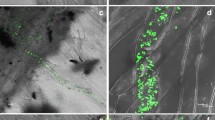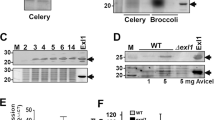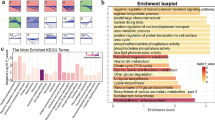Abstract
We analysed changes in the transcript population produced in habanero pepper (Capsicum chinense) cell suspensions by the addition of whole mycelium homogenates from a pathogenic isolate of Phytophthora capsici, to identify plant cellular processes modified by the oomycete effectors. The elicitation produced several defence-like cellular responses: alkalinisation of the medium, a two-step oxidative burst, induction of β-1,3-glucanases, and activation of mitogen-activated protein kinases. The elicitation modified the accumulation of transcripts representative of diverse metabolic pathways, including ethylene biosynthetic enzymes, MAP kinases and defence-related products, like PR proteins, but did not affect the expression of C. chinense NPR1 and WRKY orthologue genes, which are important modulators of plant defence responses. Interestingly, apart from some defence-related genes, inoculation of six-leaf-stage habanero pepper plantlets with the pathogenic isolate revealed few systemic modifications in the transcript patterns. All plantlets ultimately died, even though the in planta inoculation induced the strong accumulation of two MAPK transcripts. As few resistance-related genes were expressed in susceptible habanero pepper plantlets that died, either the extent or the timing of the defence response could be insufficient to establish a proper response against Phytophthora blight.





Similar content being viewed by others
Abbreviations
- MAPK:
-
Mitogen-activated protein kinase
- DOC:
-
Days of culture
- MPI:
-
Minutes post-induction
- DAI:
-
Days after inoculation
- MyH:
-
Mycelium homogenates from Phytophthora capsici
References
Birch, P. R. J., Rehmany, A. P., Pritchard, L., Kamoun, S., & Beynon, J. L. (2006). Trafficking arms: oomycete effectors enter host plant cells. Trends in Microbiology, 14, 8–11.
Bradford, M. A. (1976). Rapid and sensitive method for the quantitation of microgram quantities of protein utilizing the principle of protein-dye binding. Analytical Biochemistry, 72, 248–254.
Canto-Flick, A., Balam-Uc, E., Bello-Bello, J. J., Lecona-Guzmán, C., Solís-Marroquín, D., Avilés-Viñas, S., et al. (2008). Capsaicinoids content in Habanero Pepper (Capsicum chinense Jacq.): Hottest known cultivars. HortScience, 43, 1344–1349.
Davies, D. R., Bindschedler, L. V., Strickland, T. S., & Bolwell, G. P. (2006). Production of reactive oxygen species in Arabidopsis thaliana cell suspension cultures in response to an elicitor from Fusarium oxysporum: implications for basal resistance. Journal of Experimental Botany, 57, 1817–1827.
Dubois, M., Gilles, K. A., Hamilton, J. K., Rebers, P. A., & Smith, F. (1956). Colorimetric method for determination of sugars and related substances. Analytical Chemistry, 28, 350–356.
Eckardt, N. A. (2002). Plant disease susceptibility genes. The Plant Cell, 14, 1983–1986.
Eulgem, T., Rushton, P. J., Schmelzer, E., Hahlbrock, K., & Somssich, I. E. (1999). Early nuclear events in plant defense signaling: rapid gene activation by WRKY transcription factors. The EMBO Journal, 18, 4689–4699.
Felix, G., Regenass, M., & Boller, T. (1993). Specific perception of subnanomolar concentrations of chitin fragments by tomato cells: induction of extracellular alkalinization, changes in protein phosphorylation, and establishment of a refractory state. The Plant Journal, 4, 307–316.
Frye, C. A., Tang, D., & Innes, R. W. (2001). Negative regulation of defense responses in plants by a conserved MAPKK kinase. Proceedings of the National Academy of Sciences, USA, 98, 373–378.
Frishman, D., Albermann, K., Hani, J., Heumann, K., Metanomski, A., Zollner, A., et al. (2001). Functional and structure genomics using PEDANT. Bioinformatics, 17, 44–57.
García-Pérez, M. D., Egea, C., & Candela, M. E. (1998). Defense response of pepper (Capsicum annuum) suspension cells to Phytophthora capsici. Physiologia Plantarum, 103, 527–533.
Göhre, V., & Robatzek, S. (2008). Breaking the barriers: microbial effector molecules subvert plant immunity. Annual Review of Phytopathology, 46, 189–215.
Hamada, H., Takeuchi, S., Kiba, A., Tsuda, S., Suzuki, K., Hikichi, Y., et al. (2005). Timing and extent of hypersensitive response are critical to restrict local and systemic spread of Pepper mild mottle virus in pepper containing the L3 gene. Journal of General Plant Pathology, 71, 90–94.
Hausbeck, M. K., & Lamour, K. H. (2004). Phytophthora capsici on vegetable crops: research progress and management challenges. Plant Disease, 88, 1292–1303.
Hofmann, M. G., Sinha, A. K., Proels, R. K., & Roitsch, T. (2008). Cloning and characterization of a novel LpWRKY1 transcription factor in tomato. Plant Physiology and Biochemistry, 46, 533–540.
Jiang, R. H. Y., Tripathy, S., Govers, F., & Tyler, B. M. (2008). RXLR effector reservoir in two Phytophthora species is dominated by a single rapidly evolving superfamily with more than 700 members. Proceedings of the National Academy of Sciences, USA, 105, 4874–4879.
Kamoun, S. (2006). A catalogue of the effector secretome of plant pathogenic oomycetes. Annual Review of Phytopathology, 44, 41–60.
Kim, Y. J., & Hwang, B. K. (1994). Differential accumulation of β-1, 3-glucanase and chitinase isoforms in pepper stems infected by compatible and incompatible isolates of Phytophthora capsici. Physiological and Molecular Plant Pathology, 45, 195–209.
Lee, B. K., Kim, B. S., Chang, S. W., & Hwang, B. K. (2001). Aggressiveness to pumpkin cultivars of isolates of Phytophthora capsici from pumpkin and pepper. Plant Disease, 85, 497–500.
Leonian, L. (1922). Stem and fruit blight of peppers caused by Phytophthora capsici sp. nov. Phytopathology, 12, 401–408.
Maeo, K., Hayashi, S., Kojima-Suzuki, H., Morikami, A., & Nakamura, K. (2001). Role of conserved residues of the WRKY domain in DNA-binding of tobacco WRKY family proteins. Bioscience, Biotechnology and Biochemistry, 65, 2428–2436.
Oelke, L. M., Bosland, P. W., & Steiner, R. (2003). Differentiation of race specific resistance to Phytophthora root rot and foliar blight in Capsicum annuum. Journal of the American Society for Horticultural Science, 128, 213–218.
Park, C. J., Shin, Y. C., Lee, B. J., Kim, K. J., Kim, J. K., & Paek, K. H. (2005). A hot pepper gene encoding WRKY transcription factor is induced during hypersensitive response to Tobacco mosaic virus and Xanthomonas campestris. Planta, 223, 168–179.
Parra, G., & Ristaino, J. (2001). Resistance to mefenoxam and metalaxyl among field isolates of Phytophthora capsici causing phytophthora blight of bell pepper. Plant Disease, 85, 1069–1075.
Rayapuram, C., & Baldwin, I. T. (2007). Increased SA in NPR1-silenced plants antagonizes JA and JA-dependent direct and indirect defenses in herbivore-attacked Nicotiana attenuata in nature. The Plant Journal, 52, 700–715.
Skibbe, M., Qu, Q., Galis, I., & Baldwin, I. T. (2008). Induced plant defenses in the natural environment: Nicotiana attenuata WRKY3 and WRKY6 coordinate responses to herbivory. The Plant Cell, 20, 1984–2000.
Thabuis, A., Palloix, A., Servin, B., Daubèze, A. M., Signoret, P., Hospital, F., et al. (2004). Marker-assisted introgression of 4 Phytophthora capsici resistance QTL alleles into a bell pepper line: validation of additive and epistatic effects. Molecular Breeding, 14, 9–20.
Vleeshouwers, V. G. A. A., van Dooijeweert, W., Govers, F., Kamoun, S., & Colon, L. T. (2000). The hypersensitive response is associated with host and nonhost resistance to Phytophthora infestans. Planta, 210, 853–864.
Zhang, S., & Klessig, D. F. (2001). MAPK cascades in plant defense signaling. Trends in Plant Science, 11, 520–527.
Acknowledgements
The authors would like to thank Dr. Felipe Vázquez for the kind gift of the cell suspension culture, and M.C. Miriam Monforte, M.C. Rosa Maria Galáz, M.C. Lizbeth Castro, Dr. Ignacio Islas and Q. Ligia Brito for technical assistance. Dr. Ken Evans is also thanked for the critical review of the manuscript. This project has a CONACYT grant (P48831). YENU and RNP have CONACYT PhD fellowships (172927 and 208245, respectively).
Author information
Authors and Affiliations
Corresponding author
Rights and permissions
About this article
Cite this article
Nakazawa-Ueji, Y.E., Núñez-Pastrana, R., Souza-Perera, R.A. et al. Mycelium homogenates from a virulent strain of Phytophthora capsici promote a defence-related response in cell suspensions from Capsicum chinense . Eur J Plant Pathol 126, 403–415 (2010). https://doi.org/10.1007/s10658-009-9544-x
Received:
Accepted:
Published:
Issue Date:
DOI: https://doi.org/10.1007/s10658-009-9544-x




